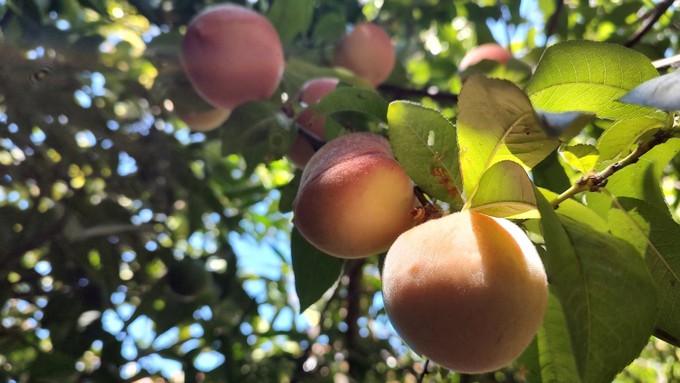
Yolo County master gardeners offer free workshop via Zoom

White peaches ripen on the tree within easy reach of picking. Summer pruning can help keep fruit trees compact and more productive. Debbie Arrington
Fruit trees can be perplexing for backyard gardeners – especially when (and how) to prune.
Here’s an opportunity to learn a lot without leaving home.
At 3 p.m. Thursday, May 23, the Yolo County Master Gardeners will host a Zoom presentation devoted to “Summer Fruit Tree Care and Pruning.” The free one-hour workshop is open to the public, no matter where they live.
“Did you know that there are benefits to pruning fruit trees in the summer?” ask the hosts. “Join experienced UCCE Master Gardener-Yolo Bonnie Berman for ‘Summer Fruit Tree Care and Pruning’ and learn the reasons for and the ‘how to’ of pruning in the summer.”
Pruning actually encourages growth. It’s also an opportunity to shape the tree, remove diseased wood and improve the health of the tree. Pruning at the right time can help set up a good harvest the following year.
For the Zoom link, contact Joan Tuss at Joan.Tuss@yolocounty.org.
Details: https://yolomg.ucanr.edu/.
Comments
0 comments have been posted.Sacramento Digs Gardening to your inbox.
Food in My Back Yard Series
April 1: Don't be fooled by these garden myths
March 25: Fertilizer tips: How to 'feed' your vegetables for healthy growth
March 18: Time to give vegetable seedlings some more space
March 11: Ways to win the fight against weeds
March 4: Potatoes from the garden
Feb. 25: Plant a fruit tree now -- for later
Feb. 18: How to squeeze more food into less space
Feb. 11: When to plant? Consider staggering your transplants
Feb. 4: Starting in seed starting
Sites We Like
Garden Checklist for week of March 30
Your garden doesn’t mind April showers. Get busy now to enjoy those future flowers.
* Get ready to swing into action in the vegetable garden. As nights warm up over 50 degrees, start setting out tomato, pepper and eggplant transplants.
* From seed, plant beans, beets, cantaloupes, carrots, corn, cucumbers, melons, pumpkins, radishes and squash. (Soak beet seeds overnight in water for better germination,)
* Plant onion sets.
* In the flower garden, plant seeds for asters, cosmos, celosia, marigolds, salvia, sunflowers and zinnias.
* Transplant petunias, zinnias, geraniums and other summer bloomers.
* Plant perennials and dahlia tubers for summer bloom.
* Transplant lettuce and cabbage seedlings.
* April is the last chance to plant citrus trees such as dwarf orange, lemon and kumquat. These trees also look good in landscaping and provide fresh fruit in winter.
* Smell orange blossoms? Feed citrus trees with a low dose of balanced fertilizer (such as 10-10-10) during bloom to help set fruit. Keep an eye out for ants.
* Apply slow-release fertilizer to the lawn.